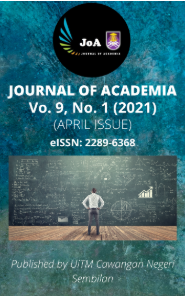A CONVENIENT SYNTHESIS OF 5-ARYLIDENE MELDRUM'S ACID DERIVATIVES VIA KNOEVENAGEL CONDENSATION
Keywords:
Biological activities, Knoevenagel condensation, Meldrum’s acid, NMR spectroscopy, one-pot reactionAbstract
A series of ten 5-arylidene Meldrum’s acid derivatives had been synthesised in excellent yield via Knoevenagel condensation. This method does not require catalyst, or any further purification. Isopropylidene malonate (2,2-dimethyl-1,3-dioxane-4,6-dione), also known as Meldrum’s acid, is utilised as a core skeleton for various kind of reactions. Meldrum’s acid has features of a peculiar ring-opening sequences based on nucleophile-sensitive carbonyl functional groups at C-4 and C-6, which has made it possible for useful synthetic transformations, as well as its high acidity of methylene hydrogen at carbon position C-5. Hence, it allows the compound to be a flexible reagent for further reaction to prepare other derivatives. Therefore, Meldrum’s acid derivatives showed high potential of biological functions, such as antibacterial, antimalarial and antioxidant activities due to the olefinic linkage which played an important role in the enhancement of antimalarial activity. Furthermore, when arylidene Meldrum’s acid transformed to epoxide, the compound showed losses of antimalarial behaviour. Additionally, this compound has unique molecules due to the high acidity of methylene hydrogen at the carbon-5 position to initiate various reactions with different functional groups. In this research, Meldrum’s acid, 3 and ten its 5-arylidene derivatives (4a-e) and (5a-e) were synthesised by using two short and efficient reaction steps. The first step involved the condensation of malonic acid, 1 with acetone, 2 in acetic anhydride and acid via one-pot reaction to give Meldrum’s acid, 3 in 50% overall yield. Having Meldrum’s acid in hand, the reaction was proceeded with the Knoevenagel condensation reaction by using various functional groups, such as aryl aldehydes and aryl amines. All the synthesised compounds were characterised by using 1H and 13C spectroscopy.
References
Bigi, F., Carloni, S., Ferrari, L., Maggi, R., Mazzacani, A., & Sartori, G. (2001). Clean synthesis in water. Part 2: Uncatalysed condensation reaction of Meldrum's acid and aldehyde. Tetrahedron Letters, 42(31), 5203-5205. doi: 10.1016/S0040-4039(01)00978-9
Ferreira, J., de Resende F. J., Batista, P., Teotonio, E., & Vale, J. (2017). Rapid and Efficient Uncatalyzed Knoevenagel Condensations from Binary Mixture of Ethanol and Water. Journal of the Brazilian Chemical Society, 29(7), 1382-1387.doi: 10.21577/0103-5053.20170240
Ghosh, S., Das, J., & Chattopadhyay, S. (2011). A novel light induced Knoevenagel condensation of Meldrum’s acid with aromatic aldehydes in aqueous ethanol. Tetrahedron letters, 52(22), 2869-2872. doi:10.1016/j.tetlet.2011.03.123
Lipson, V. V., & Gorobets, N. Y. (2009). One hundred years of Meldrum's acid: Advances in the synthesis of pyridine and pyrimidine derivatives. Molecular diversity, 13(4), 399-419. doi:10.1007/s11030-009-9136-x
McNab, H. (1978). Meldrum's Acid. Chemical Society Reviews (3): 345-358.
Noroozi, P. N., Gharib, A., Behroozi, M., & Shokr, A. (2017). New full-substituted cyclopropanes derived from the one-pot reaction of Meldrum’s acid with aldehydes and BrCN in the presence of Et3N. Arabian Journal of Chemistry, 10, S1558-S1566. doi:10.1016/j.arabjc.2013.05.024
Nestrova, I. N., Shanazarov, A. K., Poznyak, A. M., Lakoza, M. I., Shemaryankin, B. V., & Granik, V. G. (1994). Improved Method of Synthesizing 2,2-Dimethyl-4,6-Dioxo-1,3-Dioxane (Meldrum's Acid). Pharmaceutical Chemistry Journal, 28(8), 583-585. doi: 10.1007/BF02219035
Pan, W. Y., Xiao, Y. M., Xiong, H. Q., & Lü, C. W. (2016). Et 3 N catalyzed cascade reaction of Meldrum’s acid with ortho-hydroxyaryl aldehydes for the synthesis of coumarin-3-carboxylic acids under solvent-less condition. Research on Chemical Intermediates, 42(9), 7057-7063. doi:10.1007/s11164-016-2517-8
Ristovski, J. T., Janković, N., Borčić, V., Jain, S., Bugarčić, Z., & Mikov, M. (2018). Evaluation of antimicrobial activity and retention behavior of newly synthesized vanilidene derivatives of Meldrum’s acids using QSRR approach. Journal of pharmaceutical and biomedical analysis, 155, 42-49. doi: 10.1016/j.jpba.2018.03.038
Sandhu, H. S., Sapra, S., Gupta, M., Nepali, K.., Gautam, R., Yadav, S., Kumar, R., Jachak, S. M., Chugh, M., Suri, O. P., & Dhar, K. L. (2010). Synthesis and biological evaluation of arylidene analogues of Meldrum's acid as a new class of antimalarial and antioxidant agents. Bioorganic & medicinal chemistry, 18(15), 5626-5633. doi: 10.1016/j.bmc.2010.06.033
Downloads
Published
Issue
Section
License
Copyright (c) 2021 Journal of Academia

This work is licensed under a Creative Commons Attribution-NonCommercial-NoDerivatives 4.0 International License.












